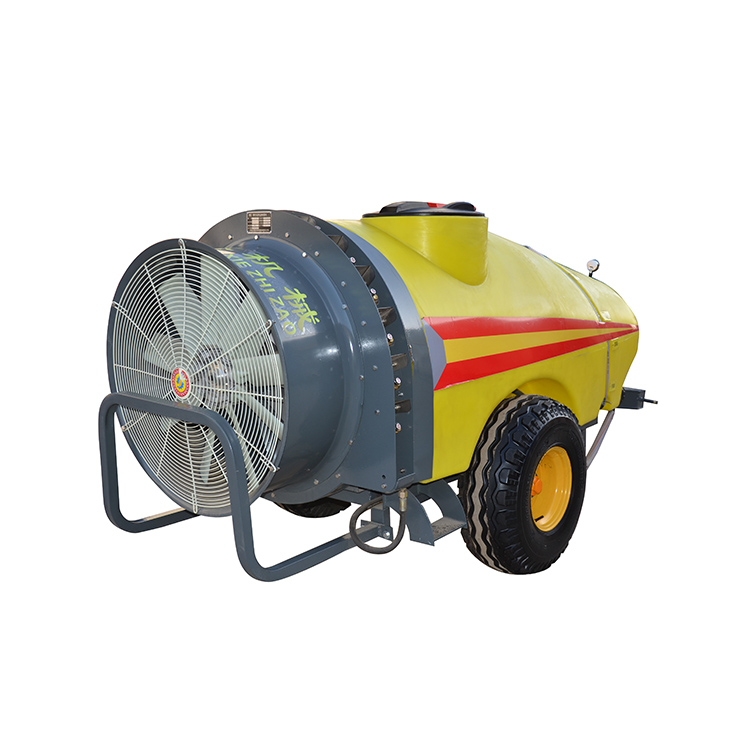Understanding Air Blast Sprayers: A Powerful Tool for Efficient Crop Protection
2025-02-13
Air blast sprayers are essential equipment in modern agriculture, widely used for applying pesticides, herbicides, fungicides, and fertilizers. These sprayers use a powerful air stream to propel liquid sprays onto crops, ensuring even coverage across large areas. Their efficiency and effectiveness have made them indispensable in farms worldwide, particularly for fruit orchards, vineyards, and row crops.
What is an Air Blast Sprayer?
An air blast sprayer is a type of agricultural sprayer designed to deliver chemicals and nutrients to crops in the form of a fine mist or spray. The sprayer uses a high-speed fan or blower to create an air blast, which helps to distribute the spray evenly over the plants. These sprayers are typically mounted on tractors or operated as standalone machines, depending on the farm's size and specific needs.
The key components of an air blast sprayer include the spray tank, the air blast system (which usually consists of a fan or blower), and the spray nozzles. The fan or blower is powered by the tractor's engine or a separate motor and directs the air through a series of adjustable ducts to propel the spray. The operator can control the direction and intensity of the spray to ensure proper coverage.
How Does an Air Blast Sprayer Work?
The process of using an air blast sprayer starts with filling the sprayer's tank with the desired liquid, which could be a pesticide, fungicide, herbicide, or nutrient solution. Once the tank is filled, the operator activates the fan or blower, which generates a high-speed airflow. The liquid is pumped through the spray nozzles, which atomize it into fine droplets.
The air blast created by the fan carries these droplets, helping them to cover the plants efficiently. The operator can adjust the direction and intensity of the airflow, allowing the spray to reach both the upper and lower surfaces of the crops. This ensures that the entire plant is treated, including hard-to-reach areas like the undersides of leaves.
The effectiveness of the air blast sprayer depends on factors such as the type of crop, the spray solution used, the wind conditions, and the sprayer's settings. Air blast sprayers are highly adjustable, allowing operators to fine-tune their settings to suit different types of applications and environmental conditions.
Advantages of Air Blast Sprayers
1. Wide Coverage:
One of the main benefits of air blast sprayers is their ability to cover large areas efficiently. The powerful airflow helps to distribute the spray evenly over the crop, reducing the number of passes required to treat the field. This efficiency saves time and labor, which is especially important for large-scale operations.
2. Even Distribution:
The high-velocity air blast ensures that the spray reaches all parts of the plant, including the hidden areas like the lower leaves and stems. This helps to achieve uniform coverage, which is crucial for the effective control of pests and diseases.
3. Flexibility:
Air blast sprayers are highly versatile and can be used for a variety of crops. They are commonly used in fruit orchards, vineyards, and vegetable fields but can also be used on row crops and other agricultural areas. The sprayer can be adjusted to accommodate different types of plants and terrain.
4. Reduced Chemical Waste:
Because air blast sprayers use a precise method of application, they help to reduce chemical waste. The air stream delivers the spray more efficiently to the target area, reducing overspray and minimizing the environmental impact. This is particularly important for sustainable farming practices, as it helps to limit the amount of pesticides and fertilizers released into the surrounding environment.
5. Increased Efficiency:
Air blast sprayers can cover more ground in less time compared to traditional hand-held or boom sprayers. The combination of airflow and misting allows the sprayer to treat large areas quickly, which is a significant time-saver for farmers, especially during busy seasons like pest outbreaks or harvest preparation.
Applications of Air Blast Sprayers
Air blast sprayers are used across various sectors of agriculture, with the most common applications being:
1. Fruit Orchards:
Air blast sprayers are particularly effective in fruit orchards, where they can cover trees with thick canopies. The powerful airflow helps distribute pesticides or fungicides evenly, ensuring that the entire tree is treated, including the undersides of leaves and hard-to-reach branches.
2. Vineyards:
In vineyards, air blast sprayers are used to apply treatments to grapevines, protecting them from pests and diseases. The sprayer’s airflow is strong enough to penetrate through the grapevines' dense foliage, ensuring that each vine receives adequate coverage.
3. Row Crops:
For row crops like corn, soybeans, and vegetables, air blast sprayers are used to apply herbicides, fungicides, and fertilizers. The sprayer can be adjusted to suit the height and spacing of the plants, allowing for targeted application and efficient use of chemicals.
4. Horticulture and Landscaping:
In horticulture, air blast sprayers are used for pest and disease control in nurseries and greenhouses. They are also used in landscaping for applying treatments to shrubs, flowers, and ornamental trees.
5. Forestry:
Air blast sprayers can be used in forestry for pest control and vegetation management. They are effective in applying herbicides or insecticides to large areas of forested land, where manual application would be time-consuming and inefficient.
Conclusion
Air blast sprayers are powerful, efficient, and versatile tools that play a critical role in modern agriculture. Their ability to cover large areas quickly and apply sprays evenly makes them an essential piece of equipment for farmers, especially those managing fruit orchards, vineyards, and row crops. With their advantages in reducing chemical waste, increasing efficiency, and providing even coverage, air blast sprayers continue to be an important tool for sustainable farming practices. As agriculture continues to evolve, the use of air blast sprayers will likely grow, helping farmers maintain healthy crops while minimizing environmental impact.



